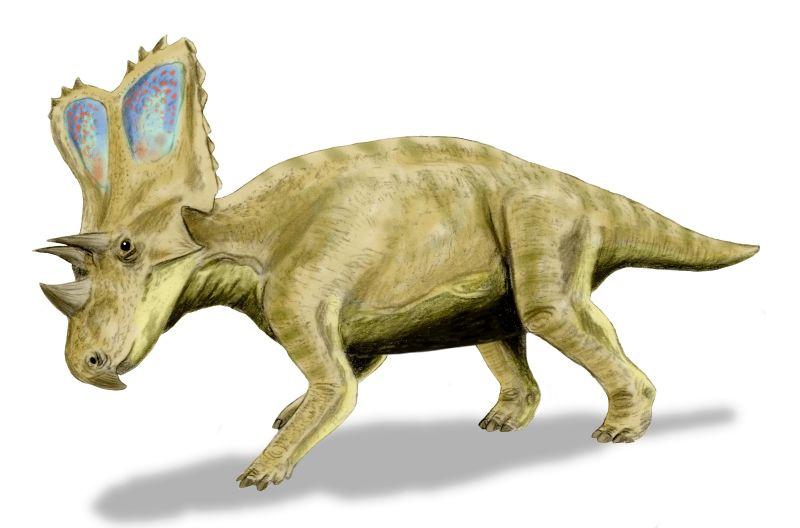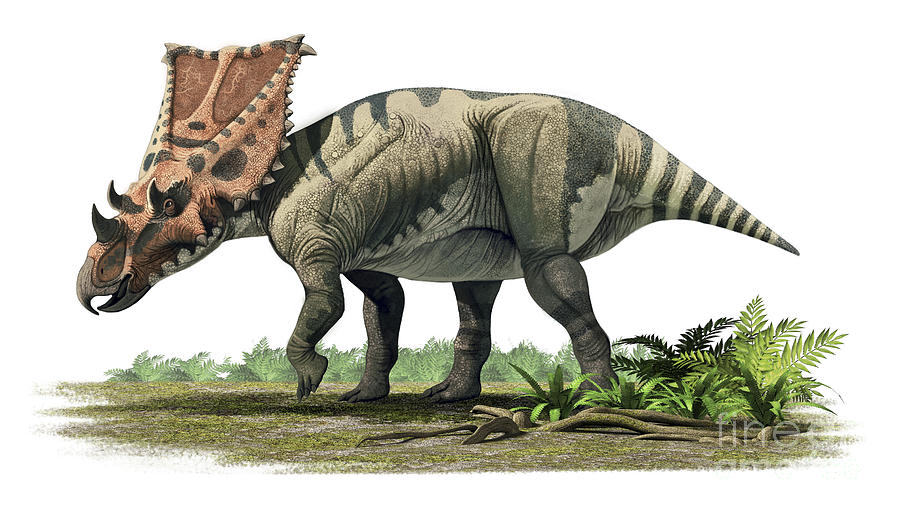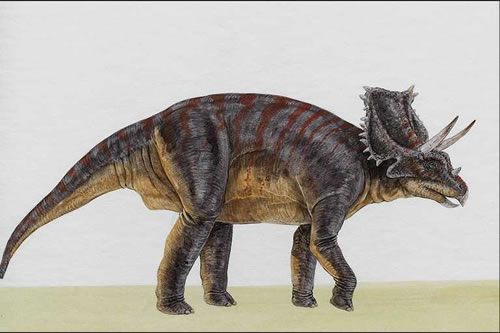Chasmosaurus
Skeletal reconstructions of C. belli
- Canada
- Chasmosaurus belli Lambe, 1914
- Chasmosaurus russelli Sternberg, 1940
- Chasmosaurus irvinensis Holmes et al. 2,001
Chasmosaurus is a genus of bird Beck dinosaurs from the group of Ceratopsidae within the ceratopsians.
Features
Chasmosaurus was around 5 meters in length and an estimated weight of 2 tons a rather small member of Ceratopsidae. His physique resembled that of the other members of this group. The skull was large and heavy, pointed snout, like all members of this dinosaur group and parrot beak similar. It was formed from the Rostralknochen (in the upper jaw ) and the Praedentale (before the lower jaw). The dentition consisted of tooth batteries, which are in rows spaced teeth that are replaced by the following tooth when worn. The occlusal surfaces of the teeth were almost perpendicular.
On the nose sat a little horn, two small horns were located above the eyes. The typical for Ceratopsidae neck shield was formed from the parietal and squamosal. He was provided with relatively long and large, paired openings.
The fuselage was powerfully built, stocky limbs. The front limbs, which ended in five toes were significantly shorter than the hind legs, which carried four provided with hooves toes. Chasmosaurus always moved away quadruped ( on all fours ).
Paleobiology
From Chasmosaurus are bone beds ( " bone stock " ) are known in which the remains of numerous animals have been found from different ages. It is conceivable that these animals at least temporarily living together in larger groups.
Horns and neck shields of Ceratopsidae are often associated with the defense against predators in context. However, after today's perspective, the headdress was primarily the identification of the individual species as well as the interaction with other dogs - either by exhibition, threatening gestures or in fighting. It may be decreased by territorial boundaries or mating privileges.
The tooth batteries of Chasmosaurus with the vertical occlusal surfaces were aligned for cutting, but not be ground movement. The pointed snout is evidence of ability to selectively food intake, the construction of the lower jaw indicates a high bite force. It is probable that this dinosaur fed on hard, fibrous plants.
Discovery and designation
All fossil remains of Chasmosaurus were found in the Dinosaur Park Formation in Alberta ( Canada). The first description was by Lawrence Lambe in 1914, the type species was C. belli. The name is derived from the Greek words chasma ( = " hole, opening " ) and sauros ( = " lizard" ) and alludes to the large openings in the neck plate on. 1940 has been described with C. russelli a second and 2001 with C. irvinensis a third type. A former fourth type, C. mariscalensis is now run in a separate genus Agujaceratops. All finds of Chasmosaurus come from the Upper Cretaceous (late Campanian ) and are about 76 to 72 million years old.
System
Chasmosaurus is classified within the Ceratopsidae in the Chasmosaurinae, which were generally characterized by a short nose horn and a long neck shield. It is closely related to Agujaceratops and Pentaceratops, together they form a basal clade within the Chasmosaurinae.










